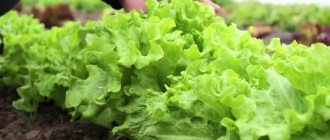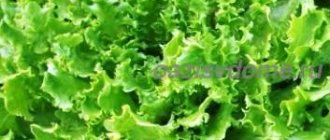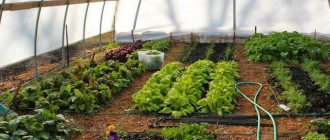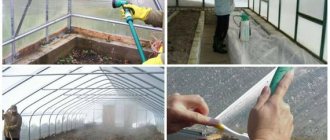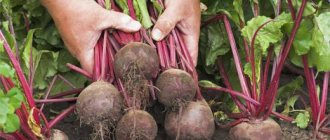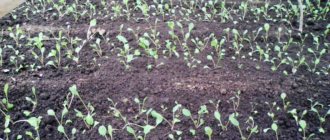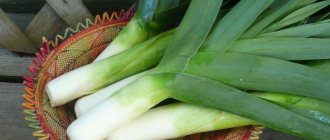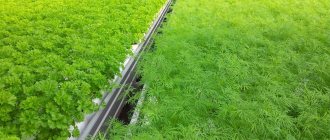Lettuce is a popular crop that can be grown in open ground, on a loggia or on a windowsill. but it is best to use greenhouses.
Indoor heated structures allow you to obtain a stable harvest throughout the year and enrich your diet with vitamins and valuable microelements.
Lettuce variety
Of these, early ripening species can be noted: “Emerald Lace”, “Moscow Wig”, “Parliament”. 20 days after planting, they form a powerful rosette consisting of a dozen leaves of marketable appearance. The optimal temperature for them is +20°C, but plant growth is possible even at +5°C.
Planting is done in rows, the distance between which should be at least 20 cm. Thickening of the seeds is allowed, which is subsequently neutralized by thinning. A temporary decrease in temperature in the greenhouse is not critical. Plant seeds remain viable even at +4-5°C, and the emerging seedlings can even withstand a slight frost down to –2°C.
Important! Knowledgeable people recommend using coated seeds, the germination rate of which is much higher than that of ordinary ones.
Useful tips from gardeners
When plants grow, it is necessary to weed it once or twice, and also loosen the areas between the rows. It will also be good to apply fertilizers with nitrogen components.
- This can be either urea in an amount from fifteen to twenty grams, or ammonium nitrate, along with potassium chloride in an amount of fifteen grams.
- All calculations are given per square meter. The fertilizer must be diluted with water before use.
- And it can be carried out once or twice at the discretion of the owner. Moreover, this procedure is performed during the growing season.
Leaf lettuce is harvested after the leaf reaches a length of at least eight centimeters. The plant, in this case, is selected along with the root. The soil must be shaken off, and the lower leaves that have dirt on them are torn off.
As for the cabbage varieties, they are simply cut off.
Experts believe that harvesting is best done in the morning. This is how plants are able to maintain their freshness for a long time. After watering, this procedure is not recommended, since the moisture of the leaves contributes to the development of the rotting process.
At the end of April, you can already start harvesting if the greenhouse is heated. If there is no heating, then the period begins in the first ten days of May.
Headed varieties of lettuce
The Bitner variety ripens in 35–45 days. Once formed, the heads of cabbage should be cut off and consumed when ripe, since after 3–5 days they will already form a flower stem.
“May” - heads of cabbage appear a little later, 2 months after germination.
“Paris Green” is the most common late-ripening variety; it is grown both by sowing lettuce in the ground with seeds and through seedlings. When sown with seeds, it produces vitamin-rich greens 2 months after germination. Heads of cabbage weigh 100–150 g, their yield reaches 3–4 kg. per square meter.
Gerberas in pots: care at home
Hydrangea photo garden planting and care
Hibiscus: planting and care in open ground
Productivity
In greenhouse conditions, lettuce grows very quickly . Head forms ripen 1.5 months after planting, leaf forms can be cut after 2-3 weeks. Cutting is done with a sharp knife, removing young leaves at the root.
After harvesting, the plants need to be watered thoroughly. Planting in portions, every 1-2 weeks, will help ensure an uninterrupted supply of greenery. From 1 sq. meters per season you can collect at least 2 kg of fresh greens. The yield of lettuce depends on the variety. The most productive include iceberg, arugula, frisee, watercress and lettuce.
Greenhouses for growing lettuce in winter
Any type of greenhouse is suitable for growing plants, such as light summer greenhouses covered with plastic film, and permanent structures made of metal profiles, covered with polycarbonate or glass. If light greenhouses allow you to somewhat lengthen the growing season of plants, then in permanent buildings you can grow lettuce all year round. Structurally, a greenhouse for growing this crop is no different from similar buildings for other vegetables. The dimensions of the buildings can be completely arbitrary, and double glazing and the presence of a vestibule at the entrance will allow you to preserve plants even in the coldest winter. It is necessary to have windows for ventilation, additional lighting and a drip irrigation system.
Selection and preparation of a greenhouse for year-round cultivation of crops
Growing lettuce on your own plot is possible in the warm season. Those who want to have fresh greens in winter will have to take care of purchasing or building a greenhouse. But the presence of a covered structure is not a 100% guarantee of a harvest. It is necessary to carry out preparatory measures before planting plants. These include: thermal insulation, automatic watering and electric heating. Among them there are both budget and expensive expensive options.
Types of designs and their effectiveness
In order to provide yourself with a harvest of lettuce throughout the year, you should decide on the choice of greenhouse. Various designs are used to grow lettuce:
- A film greenhouse is a budget and most affordable option. Its main drawback is its fragility. The greenhouse will need to be repaired every year, and after some time - a complete replacement of the film covering.
- A greenhouse made of tempered glass is an improved option. The material has high strength and thermal insulation. The cost of such a design is higher than that of a film greenhouse. And the useful life of the greenhouse is longer and there is the possibility of partial repairs if necessary.
- A polycarbonate greenhouse is an ideal option for growing various crops in winter. But from the point of view of the feasibility of growing lettuce, it is considered unjustified. Polycarbonate is an expensive and high-quality material. This coating will last a very long time. If necessary, you can replace individual sheets.
A polycarbonate greenhouse is an excellent option for growing greenery in the winter, meeting the “price-quality” criterion
Preparatory activities to improve the performance of the greenhouse
When choosing between the above options for growing lettuce in a greenhouse, you should choose a film or glass coating with a wooden base. One of the main measures to improve the microclimate in a structure is to increase thermal insulation. This can be done by covering the greenhouse with a second layer of high-strength film. It must not only withstand temperature differences, but also withstand precipitation. The main load in the greenhouse falls on the roof, so it is necessary to insulate the ceiling inside the structure. Agrofibre is quite suitable for this purpose.
Agrofibre is used not only to cover beds, but as greenhouse insulation
The desire to carry out spring sowing next year requires measures to insulate the beds. Decaying organic matter is an opportunity to naturally warm the soil. So, you can immediately achieve two goals - saving on heating and accelerating germination. Planting lettuce in the fall makes you think about artificial lighting. To do this, you will need to supply electricity to the structure or use battery-powered lamps.
Growing lettuce in winter depends on the availability of communications. Using solid fuel systems is an inexpensive option. But it requires constant presence on the site, since even a short break in the operation of the firebox at low temperatures will lead to freezing of the soil, loss of crops and failure of equipment.
Electric heating is the best way to maintain the necessary conditions in a greenhouse, but it is also more expensive. It is not advisable to use it throughout the year. Used when necessary. Electric heating is periodic in nature.
Regular watering is a prerequisite for growing lettuce, so it is much more convenient when it is automatic. The water supply system is improved as follows:
- plumbing;
- water supply via an electric pump from a well;
- regular filling of containers located in the greenhouse.
The last option is the most acceptable, since watering will be carried out with settled water at the optimal temperature.
Automatic watering greatly simplifies the process of growing lettuce
Advantages of growing lettuce in a greenhouse in winter
Growing lettuce in a greenhouse all year round has practically no disadvantages or difficulties. But there are many advantages to such planting.
- green crops grow quickly;
- salads are very healthy. They contain a large amount of water, valuable fiber, vitamins B, C, K, potassium and folic acid. The most useful are juicy varieties of bright colors;
- the taste of lettuce grown indoors is no different from the taste of plants from the garden;
- there are seeds of different varieties on sale, from simple to exotic;
- lettuce can be grown both in a heated greenhouse and in a summer greenhouse;
- you can plant different varieties of lettuce for the greenhouse, combining them with other spicy herbs and vegetables;
- a heated greenhouse makes it possible to harvest crops all year round, including in winter;
- a summer greenhouse without additional heating significantly extends the growing period, allowing you to save on heating;
- The yield of lettuce in a greenhouse is higher than in open ground, the plants are protected from pests and adverse weather conditions.
Rules for care and harvesting (instructions)
Maintaining the required temperature regime has a beneficial effect on yield. The temperature during the day, if there is a heating system, must be maintained at least fifteen to twenty degrees. At night it is usually lowered to a level of eight to ten degrees Celsius.
Such indicators are considered to be the most acceptable for good growth and development of the plant. However, practice shows that lettuce is able to grow normally even at a lower temperature of about five degrees.
It was noted that plants in which the head of cabbage has already formed are characterized by increased resistance to lower temperatures than young shoots.
To accumulate heat in greenhouses where heating is not provided, ventilation is turned off for a certain period of time.
- Water the plants only when the soil dries out. At the same time, it is worth doing it carefully so that moisture does not get on the leaves.
- Usually this procedure is carried out in the morning. They water between the rows, and do it very generously.
- If there is not enough moisture and the air in the greenhouse is excessively dry, then this has a bad effect on both the quality of the lettuce and the yield.
If there is excessive humidity, then this is also harmful, since diseases begin to spread quickly, along with the occurrence of rotting processes.
Feeding lettuce in a greenhouse in winter
If the soil is sufficiently fertile, then it is not advisable to feed the crop. On depleted soils, fertilizing is carried out once with a solution of nitrophoska (10-15 g/10 l of water) or ammonium nitrate (15-20 g/10 l of water) 2 weeks after planting. For feeding, you can use a solution of a mixture of 20 g of water-soluble superphosphate and potassium sulfate per 10 liters of water.
Mix the solutions thoroughly and pour from a fine-mesh watering can. The fertilizer solution should always be washed off the leaf surface with clean water. You can sprinkle the soil with wood ash - a source of micro and macroelements in an accessible form.
How to register a business?
On a small scale, even growing corn as a business does not require mandatory business registration. But as soon as the farmer starts selling heads of lettuce worth hundreds of thousands of rubles to shops and supermarkets, the transactions will immediately arouse unhealthy interest from the tax inspectorate. In order not to explain later where such volumes of production came from, it is better to open an individual entrepreneur or peasant farm under the favorable taxation system of the Unified Agricultural Tax. The following OKVED codes correspond to the cultivation of lettuce:
OKVED for growing Iceberg lettuce
| 01.13 | Growing vegetables, melons, root and tuber crops |
| 01.13.1 | Growing vegetables |
| 01.13.12 | Growing vegetables in protected soil |
Any agricultural activity, be it the cultivation of salads or the cultivation of Chinese cabbage, by law must be accompanied by the preparation of accompanying documents for the products. To sell goods to stores you need:
- Declaration of product conformity with GOST R safety requirements;
- An act of phytosanitary inspection to determine the absence of dangerous bacterial or viral infections in the product;
- A quarantine certificate showing that the lettuce was not grown in one of the quarantined regions.
Stem
The presented type of lettuce is characterized by a large stem on which fruits are formed.
The stem of plants of this species, like the leaves, is suitable for consumption.
Few varieties of this species are known in our country.
Svetlana
Peculiarities:
- plant length reaches 80 cm;
- weight may exceed 700 g;
- the fruits of the plant are rich in proteins;
- when cooked it has a sweetish taste;
- lettuce fruits can be pickled;
- eating this salad has a beneficial effect on the functioning of the cardiovascular and nervous systems.
Fully matures in 100 days.
Asparagus
A salad was developed with the following characteristics:
- has fruits of a grayish-green color;
- leaves are straight, of medium thickness;
- can reach 70 cm in height and 800 g in weight;
- ripens in different climatic conditions;
- is characterized by high fertility.
The average ripening period is 90 days.
Arugula
These cruciferous greens are held in high regard by many gardeners. Arugula is valued for its original aroma and spicy pepper-mustard-nut taste. The leaves and stem of the plant also contain many vitamins and other substances that are very useful for the human body. It is believed that this plant helps digestion, helps lower blood cholesterol, and is useful for losing weight.
Arugula
Arugula has the most delicious leaves - young, not overgrown leaves. They are placed in salads and other dishes to give food a unique taste inherent in this plant. Arugula is wonderful in combination with fish and seafood, meat dishes, tomatoes, garlic, cheese, olive oil. It can be used to prepare salads and okroshka. Arugula greens are tender and do not last long, so there is no need to cut them for future use.
Under the name “arugula”, seeds are sold as arugula itself, or indau sativum , as well as two-row thin-leaved , or wild Italian arugula . The plants themselves and the agricultural technology for growing them are similar. But the two-row plant is a perennial plant and in the spring it is able to grow back and produce a second harvest. And the taste of its leaves is a little sharper.
To grow arugula, you need a bed with moderate light - in the shade the plant loses its smell, in too bright sun it becomes tough and bitter. The plant is thermophilic, but can tolerate short-term frosts. You can sow seeds every 10-15 days from about the end of April. It is possible to grow arugula using the seedling method. In this case, the seeds are usually sown in March.
Arugula plants need regular watering; if there is a lack of moisture, the leaves become rough and bitter.
Read more about growing arugula in the article Arugula - growing a Mediterranean delicacy.
The best varieties of arugula: “Delicacy” , “Rococo” , “Rocket” , “Poker” , “Sicily” .
For open ground
Levistro
A late-ripening plant, the growing season lasts from fifty-five days to two months. Open sockets, medium size. The bush forms a head of cabbage, the weight of which reaches five hundred grams. There is no bitterness. The variety perfectly resists a number of diseases and dangerous parasites:
- downy mildew,
- internal necrosis,
- aphids.
Ruksai
Another salad plant with late (up to fifty days) ripening periods. The rosette is open, loose, reaches twenty centimeters in height. Rounded foliage of a reddish hue, with a slight purple color. The head of cabbage weighs about four hundred grams. Taste characteristics are expressed by brightly spicy and nutty notes.
Gascony
A mid-early plant with a growing season of forty-five to forty-eight days. The rosettes are compact, reaching thirty-five centimeters in diameter. The average weight is five hundred grams. The variety perfectly resists flowering and the most common diseases. Excellent cultivation in open ground conditions.
Good varieties for planting in the garden also include the following varieties: “Sandwich” , “Grand” , “Kitezh” , “Lola Bionda” , “Batavia” , “Oakleaf” and others. All plants are decorative, so they can be used to create landscape design in a garden or vegetable garden. They are great for creating salad dishes and can be used to decorate a “vegetable” plate.
